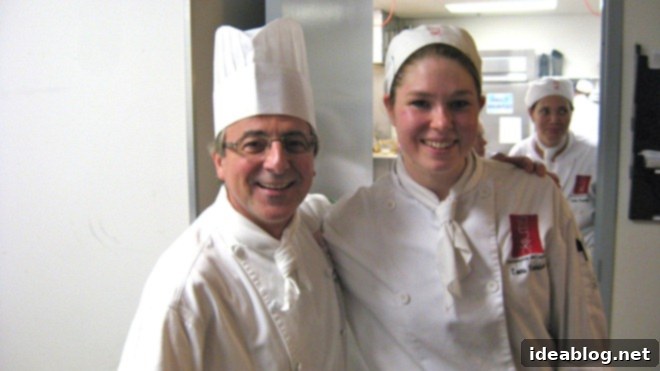Culinary Crucible: Inside a Chef-in-Training’s Two-Day Restaurant Challenge
The exhilarating world of professional cooking is often romanticized, but nothing truly prepares aspiring chefs for its demands quite like a real-world simulation. This past week, our culinary journey culminated in an intensive two-day event we affectionately call the Restaurant Challenge. For two full days, our familiar lecture room transformed into a bustling dining establishment, while our kitchen was meticulously organized into various stations, mirroring the dynamic setup of a high-volume restaurant.
Unlike our usual daily production, where we might rotate through different tasks, the Restaurant Challenge demanded unwavering focus and specialization. Each student was assigned a specific station for the entire day. In our class, these stations included a dedicated meat section, a fish station, a intricate pastry department, and the vital garde manger. This structure immersed us fully into a specific role, highlighting the importance of consistency and efficiency in a professional kitchen environment.
The stakes were considerably higher than our typical class assignments. We were encouraged to invite friends and family to dine, and the school further augmented the guest list, resulting in a bustling service of 70-90 people each day. This impressive turnout was a true test of our capabilities, especially considering our class size of merely ten students, and the notable fact that most of us had little to no prior professional restaurant experience. It was a baptism by fire, demanding quick thinking, precise execution, and seamless teamwork.
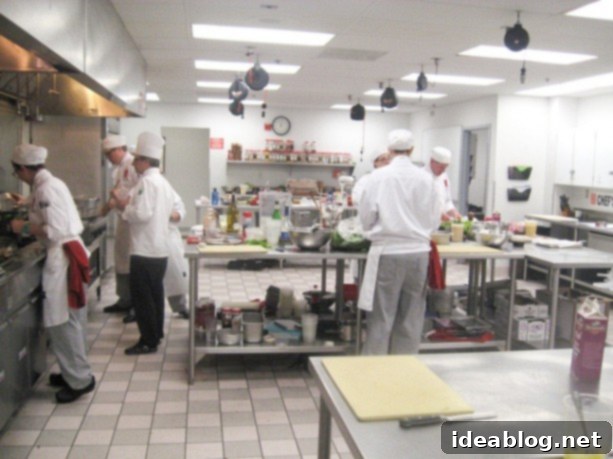
However, this was no ordinary restaurant service. To manage the immense logistical challenge and prevent an overwhelming surge of identical orders, Chef Patrice ingeniously prepared pre-set tickets for each table. Each guest enjoyed a meticulously planned three-course meal. This system allowed us to predict ingredient quantities more accurately and streamline our preparation, though it certainly didn’t diminish the intensity of the tasks at hand. Our menu was surprisingly extensive, a testament to the diverse skills we had been developing throughout our program.
The time constraints were rigorous. We were granted a mere 45 minutes for discussion and planning each morning, followed by a frantic four-hour window to prepare every dish before service commenced. Many of these dishes were entirely new to us, transforming the challenge into a dynamic learning experience where adaptability and problem-solving on the fly became paramount. We relied heavily on our collective knowledge, quick research, and instincts to navigate uncharted culinary territory.
During the peak of service, Chef Patrice commanded the pass, positioned at a head table equipped with heat lamps. He expertly expedited orders, calling out when to “fire” dishes and passing us the tickets. It was our responsibility at each station to organize these orders meticulously for their respective tables, ensuring every plate left the kitchen perfectly timed and presented. His calm demeanor belied the frenetic energy of the kitchen, providing a guiding anchor amidst the controlled chaos.
While the essence of the challenge was to create dishes from scratch, a few components offered a slight reprieve. We utilized pre-made puff pastry, nougat glacé, and chocolate tart elements, which were cleverly repurposed from the previous day’s service. This resourcefulness is a valuable lesson in itself, highlighting how professional kitchens minimize waste and maximize efficiency. Beyond these few exceptions, every other element on the ambitious menu was crafted by our own hands, emphasizing the true depth of our culinary training.
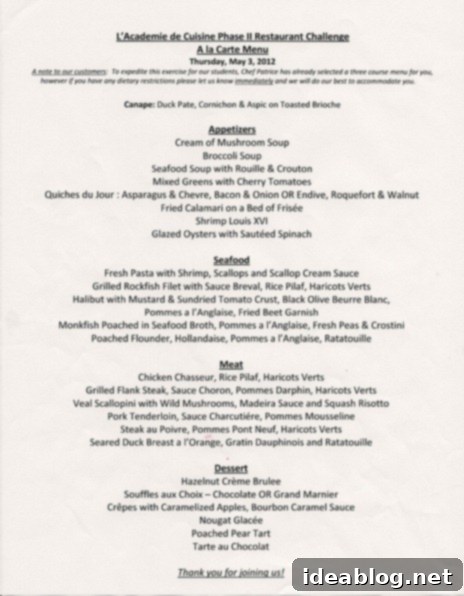
Day One: Mastering Pastry – Sweet Success Under Pressure
On Wednesday, I had the privilege of working alongside my classmate Lyndsay at the pastry station. Our day began with immediate and focused action. Our primary task was to prepare a large batch of crème brûlées. On this particular day, we crafted pistachio crème brûlées, which required ample chilling time to achieve their perfect consistency before the final torching prior to service. The following day, these would switch to hazelnut, demonstrating the kitchen’s agility in adapting offerings.
Another significant undertaking was the production of a substantial amount of soufflé base. This delicate yet demanding preparation, essentially a flour-based pastry cream, was crucial for the 25-30 soufflés we would bake to order during service. The meticulous nature of soufflé preparation, from incorporating egg whites just right to ensuring proper rise, instilled a deep appreciation for precision in pastry. We also dedicated time to rolling out puff pastry and poaching approximately a dozen pears to create our elegant poached pear tarts. Our workstation, a canvas of flour, sugar, and culinary ambition, was a testament to the organized chaos of a pastry chef’s domain.
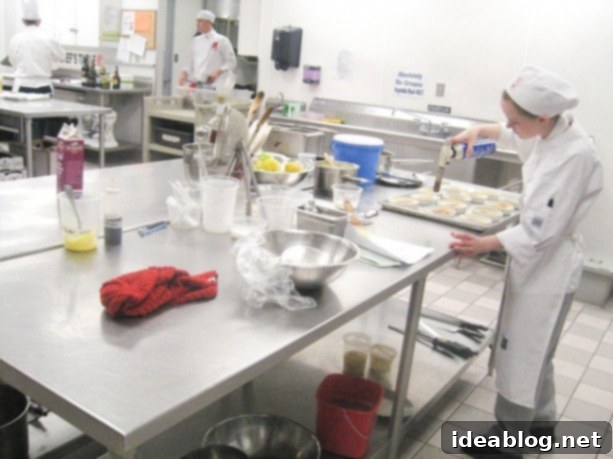
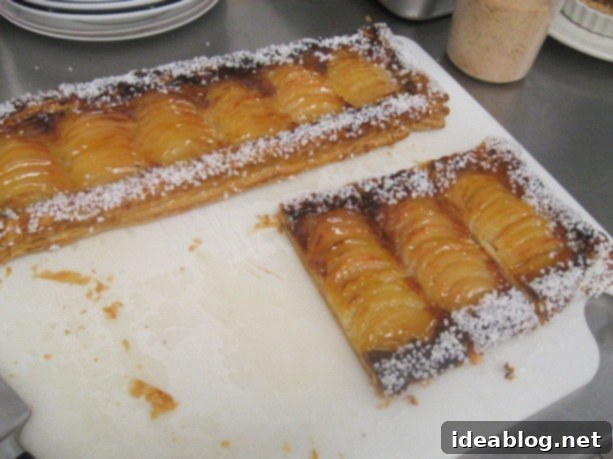
Ultimately, the pastry station proved to be surprisingly the least stressful of the four main stations on Wednesday. This was largely due to the nature of our prep work; much of it could be done in advance, allowing us to manage our time effectively. Furthermore, none of our dessert dishes required last-minute cooking to order, with the singular exception of the soufflés. For these, Chef Michel provided invaluable assistance, helping us organize and time their baking to perfection, ensuring each one arrived at the table light, airy, and impressive. This collaboration underscored the importance of a supportive team, especially under pressure.
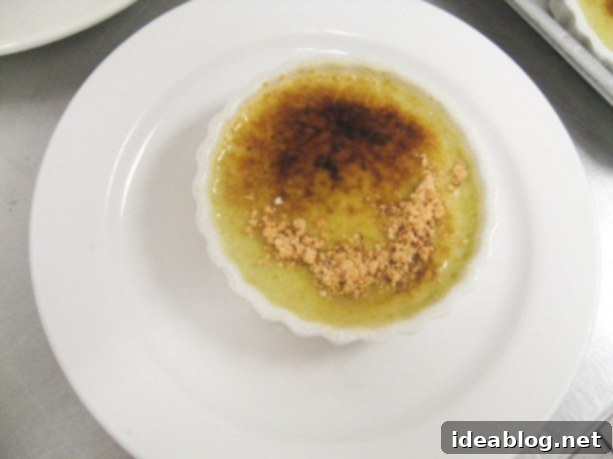
Our only true moment of feeling “in the weeds,” as the culinary parlance goes, occurred just five minutes before service was due to begin. In a collective gasp, Lyndsay and I realized we had completely overlooked making the delicate tulipes, essential for elegantly holding our nougat glacé. A brief, frantic scramble ensued, but with quick teamwork and a touch of adrenaline, we managed to rectify the oversight just in the nick of time. This small but significant hiccup served as a potent reminder that even in a well-planned kitchen, unexpected challenges can (and will) arise, demanding swift and decisive action.
Overall, Wednesday at the pastry station proceeded remarkably smoothly. However, a palpable sense of anticipation hung in the air, as we both knew that Thursday would likely assign us to either the meat or fish station. These stations, each typically manned by three individuals, were widely regarded as the most demanding and high-stress roles among the four. The intensity of a culinary career became strikingly clear when, immediately after cleaning up the kitchen, I headed directly to a catering event for a fellow L’Academie alum. By the end of that day, physical and mental exhaustion had truly set in.
Day Two: The Fish Station Fray – A Test of Skill and Endurance
Thursday dawned, bringing with it a fresh wave of challenges. Upon arriving at school, I learned my assignment: the fish station. This was arguably the most complex and demanding of all the stations, requiring utmost precision, speed, and a deep understanding of delicate protein cookery. I joined Kevin and Jim, my teammates for the day, and we immediately plunged into the whirlwind of morning preparation. While Kevin and Jim focused on various crucial tasks, I tackled my own extensive list, which offered a stark glimpse into the sheer volume of work involved:
- Tourneed Potatoes: A delicate art form, I was responsible for perfectly shaping over 60 tourneed potatoes for service. This laborious task, requiring consistent knife skills and an eye for detail, was certainly a test of patience and precision.
- Pasta Dough: Crafting fresh pasta from scratch added another layer of complexity, demanding careful attention to texture and consistency.
- Beet Garnish: Frying and meticulously preparing our vibrant beet garnish required careful temperature control and an understanding of visual appeal.
- Rice Pilaf: Preparing a large batch of flavorful rice pilaf to accompany dishes from both the meat and fish stations meant ensuring perfect grain separation and seasoning.
- Chopping Parsley: A seemingly simple task, but chopping a substantial quantity of parsley for various garnishes highlighted the foundational importance of mise en place.
- Cleaning Shrimp: The meticulous process of cleaning and preparing shrimp underscored the need for hygiene and careful handling of seafood.
- Olive Beurre Blanc: Crafting our exquisite olive beurre blanc sauce, destined to complement a delicious halibut dish (a recipe fondly remembered from Day 49), required careful emulsification and temperature management.
- Hollandaise Sauce: Preparing a significant quantity of hollandaise sauce, using 15 eggs, presented its own set of challenges, especially when it unexpectedly broke during service, demanding quick thinking and a swift rescue operation.
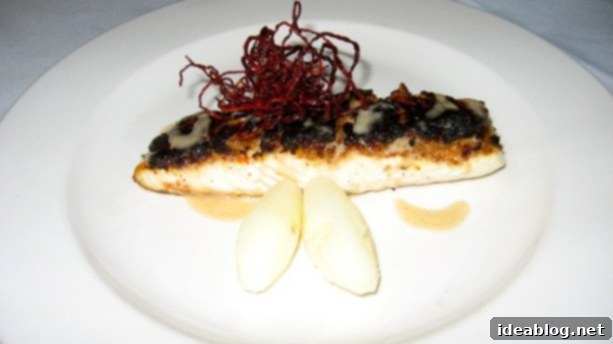
We pushed ourselves to the absolute last minute, barely getting everything organized before the call for service. Then, the true test began. Service itself felt like a blur, a whirlwind of heightened senses and adrenaline. Our sabayon for the oyster dish unfortunately broke, forcing me to quickly whip up a new batch within minutes – a true testament to the “cook on the fly” mentality. Adding to the chaos, our hollandaise sauce decided to break not once, but twice, demanding immediate attention and rapid corrective action. There were also moments of genuine confusion regarding the precise assembly of a couple of our complex dishes, requiring quick huddles and clarifications.
In the thick of it, Kevin largely managed the cooking line, expertly searing proteins and timing components. I assumed the role of the middleman, primarily in charge of plating and providing crucial support to Kevin whenever he needed an extra pair of hands. Jim, with his organizational prowess, meticulously managed the incoming tickets, ensuring no order was missed or delayed. It was a fluid, intense dance, requiring constant communication and immediate responsiveness. The heat, the clatter of plates, the shouted commands – it was a symphony of culinary pressure.
Frankly, I didn’t feel particularly great about our performance at the fish station during service. The broken sauces and moments of uncertainty weighed heavily, especially knowing that my mom, godmother, Connor, and both of his parents were dining with us that day. The pressure to perform flawlessly for loved ones amplified the stress. However, to my immense relief, after service concluded, they raved about every dish, declaring everything delicious. Perhaps the adrenaline and self-critical eye distorted my perception, and in the end, everything turned out well?
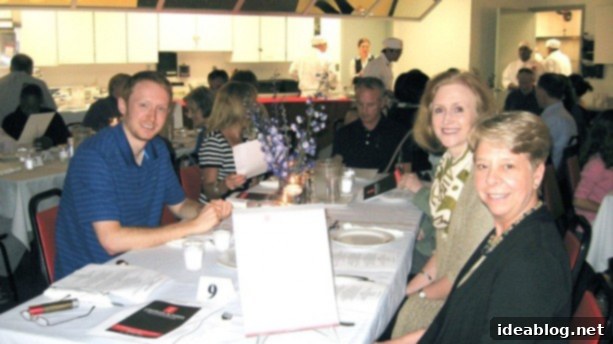
After the intense service, I finally had a moment to show my family around the now quieter, but still warm, kitchen. It was a chance to relax a bit, though the exhaustion was palpable. We were all sweaty, physically drained, but buzzing with the afterglow of a challenging but successful endeavor. The glistening sweat on my face was a badge of honor, a tangible sign of the effort expended.
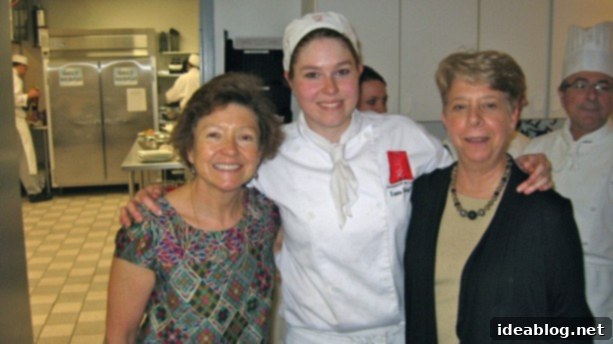
And here I am with the ever-calm and collected Chef Patrice, who always seemed to effortlessly navigate the storm with an unwavering composure. His ability to guide, critique, and inspire under pressure is truly remarkable and a benchmark for us aspiring chefs.
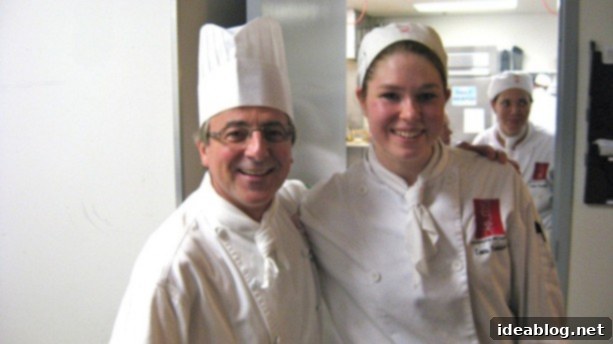
Reflections on the Culinary Gauntlet and What’s Next
In retrospect, I am incredibly impressed that our small class was able to pull off such a massive undertaking. For many of us, this was a completely new and intimidating experience, yet we rose to the occasion. The feedback we received was particularly gratifying: according to several school staff members, our class was notably speedy in getting dishes out within a reasonable timeframe, surpassing some previous classes. This recognition was a huge confidence boost and a testament to our collective hard work and growing skills.
By the time we finished the extensive kitchen cleanup and grabbed some well-deserved leftovers for a late lunch, it was already 4:00 PM. But the culinary journey didn’t end there. The very next day, we were back to planning and sourcing ingredients for our Fourth Market Basket Challenge. This iteration promises to be even more intricate, involving an expanded array of dishes and a collaborative effort with the Phase II pastry students. This continuous progression ensures our skills are constantly honed, pushing us beyond our comfort zones and preparing us for the multifaceted demands of the culinary industry.
More details on the exciting Market Basket Challenge are still to come, and I was finally able to capture a few pictures to share the experience! This intense two-day challenge has been invaluable, providing a taste of the real-world pressures and immense rewards of working in a professional kitchen.
Hope everyone has a great weekend, and stay tuned for more culinary adventures!
